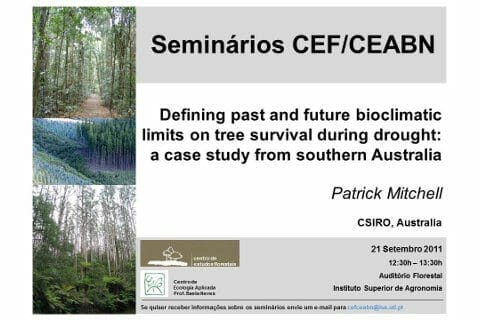Dr Patrick Mitchell from CSIRO, Australia, will be delivering a seminar on “Defining past and future bioclimatic limits on tree survival during drought: a case study from southern Australia” on the 21th of September at the Forestry Auditorium from the Instituto Superior de Agronomia, Lisbon, Portugal.
Abstract of the Seminar provided by Dr Patrick Mitchell :
“Drought-induced tree mortality in natural ecosystems is thought to be increasing worldwide. Many tree species show a large degree of plasticity in their ability to cope with changes in water availability under variable climates. Southern Australia exhibits inter-decadal shifts in rainfall and future climate scenarios in this region show significant increases in the frequency and areal extent of exceptionally hot and dry periods. Few studies to date have related such predictions to the observed bioclimatic limits that determine tree survival. In this presentation, the history of drought-induced mortality events across southern Australia is reviewed with the objective of defining the climatic drivers of mortality within the context of the underlying physiological mechanisms involved in tree death. The observed climate patterns were assessed using standardised precipitation and evapotranspiration indices (SPEI) and heat stress values for several mortality sites across the region. The majority of mortality events represented periods when both SPEI and heat stress were above their 95th percentile and were exceptional events in terms of either their intensity or duration. The conditions needed to produce the observed mortality events fell well outside the normal operating ranges of these species and were exacerbated by acute heat stress in most cases. I will present future drought scenarios and a sensitivity analysis of changes in temperature and rainfall in defining the drought type and its effect on plant functioning. Results from drought physiology experiments will also be discussed in the context of the climate drivers of mortality and the physiological pathway of tree mortality for some commercially-important tree species worldwide.”
